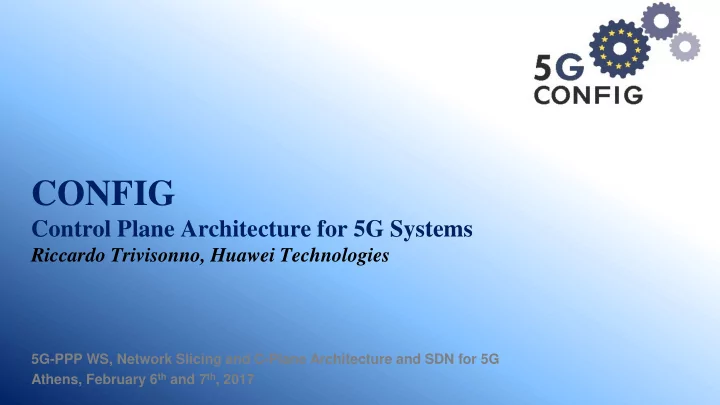

CONFIG Control Plane Architecture for 5G Systems Riccardo Trivisonno, Huawei Technologies 5G-PPP WS, Network Slicing and C-Plane Architecture and SDN for 5G Athens, February 6 th and 7 th , 2017
Presentation Outline • Project Objectives • Project Achievements and Relationship to Network Slicing • Open Issues and Next Steps Slide 2 – CONFIG
Project Objectives To build 5G on top of the key High Level Requirements at the time the project proposal was written (‘14) , CONFIG identified 4 key objectives: Develop a 5G modular functional framework ( Architecture Flexibility / Vertical Integration ) Slicing Concept Looming Conceive an access-agnostic 5G Core Network ( Heterogeneous Access Integration ) Develop a Context Information framework ( Providing Smart/Tailored Connectivity ) Lead standardisation future paths, impacting on 3GPP, IETF, ONF ( Impact on Real Systems ) Slide 3 – CONFIG
Project Objectives: Architecture Modularisation Zooming-in the Control Plane Modularisation as design principle, Key Network Slicing enabler allowing flexibility and Verticals integration Slide 4 – CONFIG
Presentation Outline • Project Objectives • Project Achievements and Relationship to Network Slicing • Open Issues and Next Steps Slide 5 – CONFIG
Project Achievements: 5G Modularised Architecture, Supporting Network Slicing Network Functions and Interfaces Context Awareness Framework Slide 6 – CONFIG
Relationship to Network Slicing Definitions and Lifetime Consolidated Definitions, NGMN, Jan’16 Logical Architecture Management Network Slice Blueprint: A complete description of the structure, configuration and the plans/work flows for how to instantiate and control the Network Slice Instance during its life cycle Control/User Plane Infrastructure Network Slice Instance : a set of network functions, and resources to run these, forming a complete instantiated logical network to meet certain network characteristics required by the Service Instance(s) CONFIG Definition and Scope of Network Slicing: A network slice is an independent logical network, defined by the interconnection of a set of basic building blocks, composing both C-plane and D-plane, and which can be independently instantiated and operated over a set of physical infrastructure, to support the communication service requirements of a particular or multiple use cases. End to End: a network slice spanning all the components of the communication system needed to provide devices with the requested communication service Slide 7 – CONFIG
Relationship to Network Slicing: Example: mIoT Network Slice C-plane Procedures C-plane Architecture ViD 1 ViD 1 PhD1 PhD2 AN CM/FM SAM DPG PhD1 PhD2 AN CM/FM SAM DPG 1. Connection Request 1. Connection Request 2. Connection Ack 2. Connection Ack 3. Connection Complete 3. Connection Complete 4. Connectivity Request Fwd 4. Connectivity Request Fwd 5. Credential Verification 5. Credential Verification 6. Credential Verification OK 6. Credential Verification OK 7. VD ADD allocation 7. ViD Add 8. VD ADD to Ext Add Translation Rule association 9. Aggregate CN Bearer Establishment 8. Connectivity Request Ack 10. Connectivity Request Ack 9. Connection Reconfiguration 11. Connection Reconfiguration 10. Connection Reconfiguration Ack 12. Connection Reconfiguration Ack ViD 1 PhD1 PhD2 AN CM/FM SAM DPG ViD 1 PhD1 PhD2 AN CM/FM SAM DPG 1. Data Received 1. Data To Send 2. Data Packet Fwd 2. UL Data Token Grant 3. Data Ready 3. Data Packet 4. Ready to Receive 4. Data Packet Fwd 5. Data Transmission Slide 8 – CONFIG
Relationship to Network Slicing: Standardisation (3GPP SA2 Perspective) A Network Slice is a complete logical network made up of Access and Core Network Components • Slices are selected based on NSSAI provided by the UE CP CP … NSS NFn CP • RAN selects a CCNF (AMF/NSSF) based on the … NF1 CP AI … CP NFn CP NF1 Common CP NSSAI NF1 NFn UE RAN NFs UP • An NSSAI can generate multiple Network Slices 1 UP {CCNF) … NFn UP … NF1 UP • An AN can be common to all slices … UP NFn UP NF1 NF1 NFn • The NSSAI includes at least: SST and SD • CCNF Redirection can be done at RAN or CCNF CCNF NSI NG smf • SMF Selection is based on: CP CP • NSSAI (Provided by the UE), UE Subscription SM AMF NG1 F Info, DNN and Local Operator policies UE NG2 NG4 • SM-NSSAI can be associated to an application 1 UP • Data is routed to the PDU sessions associated to NG3 NG6 RA UP DN N the SM-NSSAI 9 F RAN SLICE Slide 9 – CONFIG
Relationship to Network Slicing: Standardisation (3GPP SA2 Perspective) Network Slicing was NOT the focus of SA2 118 bis … Network Slicing embedded in other procedures • It is not decided whether NSSF is a separate function or a CCNF component within AMF • Slicing is not a mandatory feature, but AMF is always CP AMF required NG 1 • NSSF can be accessed even before an AMF has been UE CP 1 NSSF selected • It is not decided whether Network Slicing should be addressed as a separate feature or part of existing NF_B NF_A NF instance procedures instance Repository Function Determine to access the • Should NS have its own clause within the TS? function of NF_B 1. NF Discovery Request (Function type of NF_B, service related parameters) • To be determined during normative phase what Slice- 2. Check whether the related info is to be used for NF selection request is allowed 3. NF Discovery Response • E.g., Is the NSSAI used as an input to NF selection? 4. NF Access • It is not clear how Network Slicing is handled in a Roaming scenario Slide 10 – CONFIG
Thank You! Riccardo Trivisonno, PhD riccardo.trivisonno@huawei.com
Recommend
More recommend